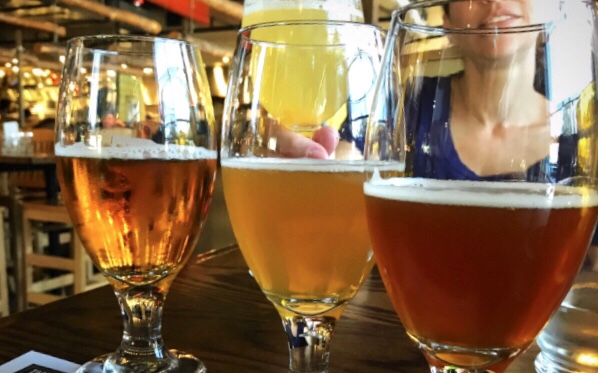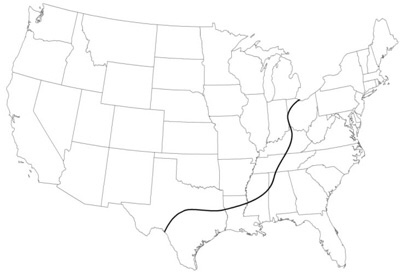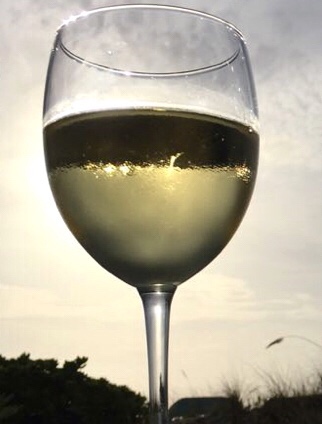 What’s the best alcohol for the environment? Beer, wine, whisky, vodka, cider? Unfortunately, there isn’t one easy answer. But there is a path to drink a more environmentally friendly booze. I’ll show you that path by presenting the factors that make your favorite drink more or less earth-friendly. There’s a plethora of information here, including the debate between bottles and cans. This is your guide to drinking the best alcohol for the environment.
What’s the best alcohol for the environment? Beer, wine, whisky, vodka, cider? Unfortunately, there isn’t one easy answer. But there is a path to drink a more environmentally friendly booze. I’ll show you that path by presenting the factors that make your favorite drink more or less earth-friendly. There’s a plethora of information here, including the debate between bottles and cans. This is your guide to drinking the best alcohol for the environment.
Here’s the path to drinking the best alcohol for the environment.
Walk or bike to a brewery, distillery, or winery for a drink at the source made from local raw materials, in bulk, with organic ingredients, powered with renewable energy, and they give back to environmental causes. Then reuse the glass.
If you can’t make it to the source and want a drink at home, follow the same plan, and buy in bulk containers. Recycle the container.
Environmental Factors
An environmental life cycle needs to consider the drink from raw materials to waste. This includes the materials used for the drink and packaging, production process, distillation practices, water use, transportation, refrigeration, and waste management. The impacts on the environment include greenhouse gas (GHG) emissions, toxic air pollutants, water use and pollution, habitat destruction, and more.
Here are the 3 largest aspects of alcohol production.
- Raw materials: The grain or fruit for the alcohol and the materials for the container and packaging.
- Production: The electricity use (coal, natural gas, nuclear, or renewable), refrigeration, water use, and waste management.
- Transportation: The further the alcohol has to travel to get to you, the more fuel, refrigeration, and GHG it will produce.
If you can make reductions to any or all of those, you’re on your way to a greener drink.
Wine
Wine’s biggest environmental impact is from transportation. Shipping heavy glass bottles from the Loire Valley, France to Denver, CO or from Napa, CA to Miami, FL uses a lot of fuel and therefore produces a lot of GHG.
The below map is a good reference to choosing a wine that produces less GHG, based solely on transportation. If you’re on the east side of the “green wine line” you’re better off drinking French wine over California wine. And the reverse if you’re on the west side.

U.S. map showing the approximate GHG breakeven line between Bordeaux and Napa wines, from (2009)
- Wine doesn’t require heating during
 production. That gives it an advantage over beer and spirits, which need considerable heating.
production. That gives it an advantage over beer and spirits, which need considerable heating. - Wine doesn’t uses nearly as much water as brewing beer or distilling spirits.
- Box wine and aseptic container wine are lighter than glass and can hold more wine.
- Make sure you recycle the container. The plastic liner in box wine isn’t recyclable everywhere, but always recycle the cardboard.
- Along with GHG production, there is a concern of wines containing toxic arsenic. This is more an impact on your health then the environment. This article has everything you need to know about that.
Best wine for the environment: Drink quality wine at the winery form a reusable glass. At home, drink wine shipped and packaged in bulk, made as close to you as possible. Recycle the package.
All of that might make wine an overall better choice than beer. Not so fast, my friend.
While beer accounts for around 80.5% of alcohol consumption by volume, it emits only 62% of alcohol emissions. Wine’s volume share of alcohol consumption is 16% but its emissions contribute over 27% to the alcohol total. For spirits, the total volume of consumption is 3.5%, while its share of emissions is 6.7%.*
Therefore, per drink, beer produces less GHG than wine and spirits.
Beer
There seems to be more information about the environmental impact of beer, probably because beer is the largest volume of alcohol. And partly due to New Belgium Brewing. They’ve been a leader in brewing environmentally friendly beers for quite some time. In fact, they conducted a study on the carbon footprint of producing their Fat Tire Amber ale.
- The two factors that produce the most GHG are refrigeration (33% of the GHG) and glass production (22% of the GHG).
- Water use is another big impact. A rule of thumb is that breweries use 5-10 times more water than actually leaves the premises as beer.
- The above water use doesn’t account for the water used to grow the grain.
- The brewing process accounts for less than 20% of the overall environmental impact. It’s the raw materials, refrigeration, water use, packaging, and transportation that make up the most impact.
Bottle vs Cans
- Glass bottles are made from silica. Silica is easier to acquire and has less environmental impact than mining bauxite for aluminum cans. Mining bauxite has huge impacts on the environment, as most mining does.
- Manufacturing a 12-ounce aluminum can is twice as energy-intensive as making a similarly sized glass bottle: 2.07 kilowatt hours of electricity for the can vs. 1.09 kilowatt hours for the bottle.
- Bottles seem to have an early lead on being more environmentally friend. And they do. But now it gets complicated.
- Aluminum cans most often contain more recycled content than glass bottles. If the brewery uses high content recycled aluminum, then gap between can and glass narrows.
- Cans are lighter than bottles. For beer that makes a cross country truck journey, a bottle ends up emitting 20 percent more GHG than a can.
- Producing recycled cans uses less raw materials and GHG than bottles. Uh oh, who’s winning now?
- A good rule of thumb: If the brewery is close to where you’re drinking and there is a good glass recycling program, drink bottles. If the brewery is far away, drink cans.
Best beer for the environment: You walk to an environmentally conscious brewery and drink the beer at the source from a reusable container.
A study showed that drinking a locally brewed cask ale in a pub can produce as little as 300g CO2e. While a bottled beer that was transported a long way can be responsible for as much as 900g CO2e.
Worst beer for the environment: Drinking a bottled beer that was brewed and packaged on the other side of the planet. And then not recycling the bottle.
 Spirits
Spirits
- Distilling spirits uses more water per ounce of any alcohol.
- Whiskey’s biggest energy expenditures are farming the grains and the distilling process. Whiskey encompasses a variety of ingredients and styles. A more complex distillation process uses more energy and water.
- Vodka requires more water and energy than other spirits to distill. It is distilled down to 95% ethanol.
- Rum comes from sugarcane, which is a destructive crop, producing wastewater and GHG. The impacts of sugarcane production includes loss of biodiversity, water pollution, erosion, and slash and burn agriculture.
- The EPA hit Bacardi in 2001 for illegally dumping wastewater into Puerto Rico waters.
- Tequilla comes from agave, which grows slowly and is vulnerable to pests. Agave farms therefore use a lot pesticides. Pesticides can pollute the food source and the water.
- Tequila has a waste problem. Each liter of tequila produces about 11 pounds of pulp and 10 liters of vinazas, or hot acidic waste. The vinazas can end up polluting soil and water in Mexico’s Jalisco state, where most tequila comes from.
Best spirit for the environment: Drink a local whiskey at the distillery. At home, try something made locally. If you’re in the United States, drink a Kentucky bourbon over an Irish whiskey or Mexican tequila. Makers Mark whiskey bourbon uses locally sourced grains and has very good environmental practices.
Cider
After all of the above is said and done, cider might be best alcohol to drink for the environment.
- Cider has a simple production process compared with other drinks. Wash, grind, and mash the apples, then let fermentation do its thing.
- Apple orchards are simple forests. Although orchards are not as biodiverse as a real forest, trees absorb more carbon dioxide than any other plant. Carbon dioxide is a GHG.
- An apple orchard can be a more sustainable habitat for wildlife than barley, hops, corn, agave plants, or sugar cane.
Have you figured it out yet? What’s the best alcohol for the environment?
Based on a lot of this information, drinking local cider or wine seems to beat out beer and spirits. But it’s not that easy. Use the list below as a checklist. Find a brewery, distillery, or winery that checks off as many of these as possible.
- The drink is local to you.
- It’s made with local raw materials.
- They limit their energy footprint by using renewable energy.
- They compost, reuse, and/or recycle their waste.
- They support environmental causes
- Drink from bulk containers (kegs, big bottles) in reusable cups and glassware.
- Drinking local doesn’t necessarily mean drinking small batch or craft. The big guys are often more efficient per ounce than the small batch producers.
What about making your own alcohol?
That’s as local as you can get. It removes all the impacts from big production, packaging, and transportation. But you still need the raw materials. And you lose the efficiency of large production volumes.
I guess this means I need to plant some hops in the backyard garden and put a Kegerator in my house filled with my own home brew.
Cheers.
References for more reading.
- https://grist.org/article/what-kind-of-liquor-is-best-for-the-environment/
- https://www.theguardian.com/environment/green-living-blog/2010/aug/31/alcoholic-drink-environmental-impact-worst
- https://blueandgreentomorrow.com/society/environmental-impact-alcohol-production/
- http://www.isonomia.co.uk/?p=4770
- https://www.researchgate.net/publication/273068895_Environmental_Sustainability_of_the_Wine_Supply_Chain_–_A_Review
